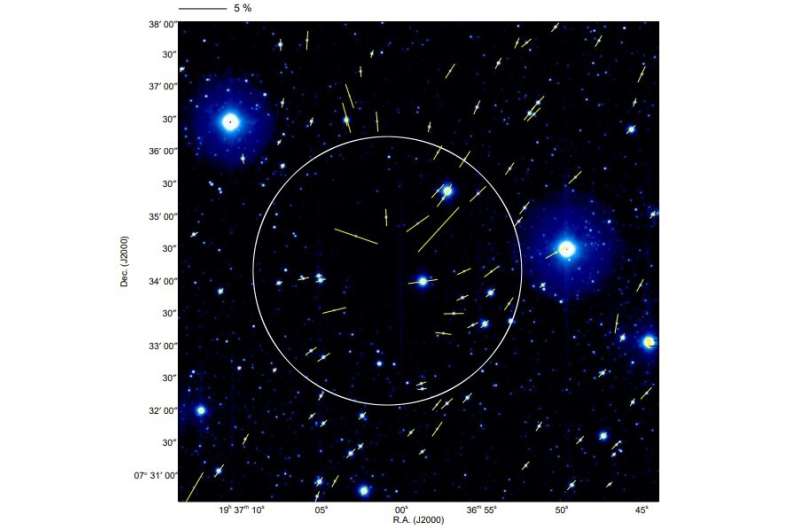February 3, 2020 report
Observations detect distortion of magnetic fields in the protostellar core Barnard 335

Using the South African Astronomical Observatory (SAAO), Japanese astronomers have investigated the magnetic field structure of the protostellar core Barnard 335. The new observations suggest that the magnetic field of Barnard 335 is distorted, which could have implications for our understanding of the nature of this object. The finding is detailed in a paper published January 22 on arXiv.org.
Protostellar cores represent early stages of stellar formation. Processes taking place in these cores determine the initial composition of protoplanetary disks. Astronomers are especially interested in studying magnetic fields of protostellar cores as their role in the early stages of star formation is still not well understood.
Located some 342 light years away, Barnard 335 (or B335 for short) is an isolated dense protostellar core with a mass of about 3.67 solar masses and a radius of approximately 13,100 AU, containing a far-infrared source known as IRAS 19347+0727. This source is classified as a Class 0 protostar, which shows strong sub-millimeter emissions and is associated with a dense molecular gas envelope.
Although the magnetic field of B335 has been a subject of several studies, still many questions about its properties remain unanswered. For instance, they a large uncertainties regarding the magnetic field strength as some studies estimate that this parameter is at a level between 12 and 40 µG, while the others point out to even 134 µG.
A team of astronomers led by Ryo Kandori of National Institutes of Natural Sciences (NINS) in Japan has employed the Infrared Survey Facility (IRSF) 1.4-m telescope at SAAO to get more insights into the magnetic field of B335 and to resolve the uncertainties about its properties. By conducting near-infrared polarimetric observations of background stars, the researchers were able to unveil the detailed magnetic field structure of the protostellar core.
"In this study, the detailed magnetic field structure of the dense protostellar core Barnard 335 (B335) was revealed based on near-infrared polarimetric observations of background stars to measure dichroically polarized light produced by magnetically aligned dust grains in the core," the paper reads.
In result of the study, axisymmetrically distorted, hourglass-shaped magnetic fields were identified for the first time in B335. The magnetic inclination angles in the plane-of-sky and line-of-sight directions were determined as 90 and 50 degrees, respectively.
The total magnetic field strength of B335 was calculated to be about 30.2 µG. The magnetic critical mass of the core was found to be approximately 1.13 solar masses, which is less than the observed core mass. Moreover, the critical mass of B335, evaluated using both magnetic and thermal/turbulent support, was measured to be around 3.37 solar masses, what is similar to the observed core mass.
According to the researchers, the results indicate that the studied protostellar core commenced its contraction from the condition near the equilibrium.
"Thus, B335 is considered to have started its contraction from the condition near the equilibrium. Further, we speculate that the (spontaneous) low-mass star formation in globules is generally initiated in the state close to the critical condition," the astronomers concluded.
More information: Distortion of Magnetic Fields in Barnard 335, arXiv:2001.08542 [astro-ph.GA]: arxiv.org/abs/2001.08542
© 2020 Science X Network





















